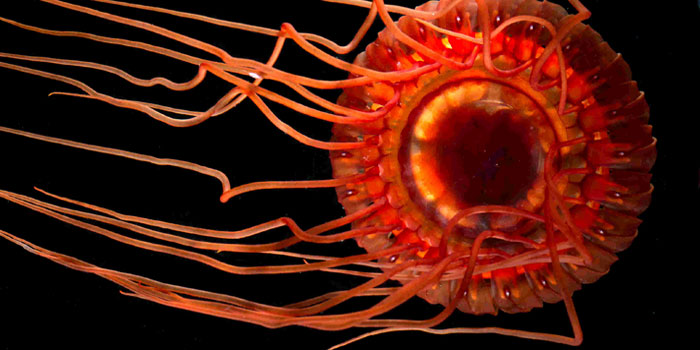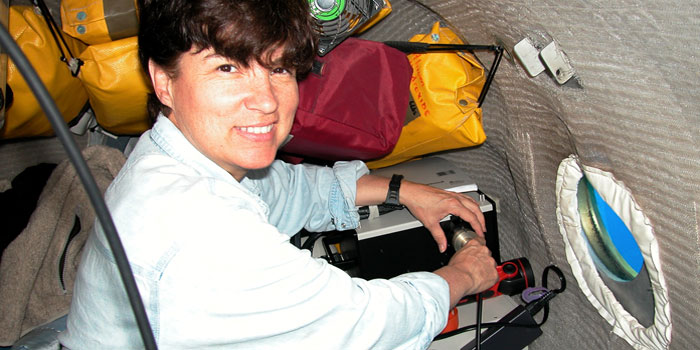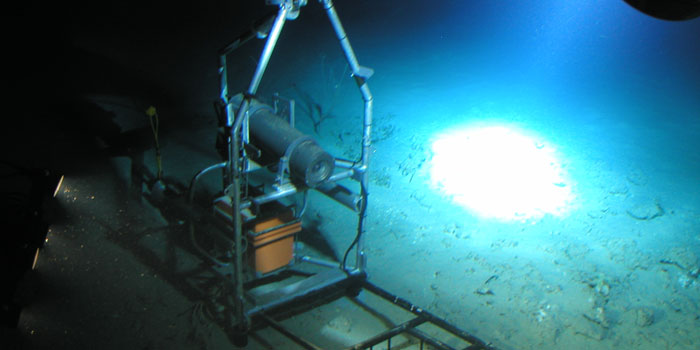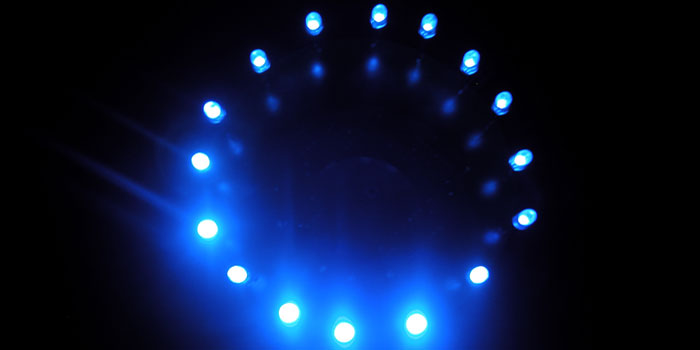Dr. Edith A. Widder: Video Transcript
Hear Edie talk about her job, using submersibles to study marine life, and trials and tribulations of life at sea. Download (mp4, 188 MB).
Introduction
My name's Edie Widder and I am a senior scientist at Harbor Branch Oceanographic Institution which is on the east coast of Florida. A research scientist is someone who asks questions, and then explores answers by forming what are known as multiple alternative hypotheses. Then we set up experiments to test these hypotheses. You can never prove a hypothesis, but you can disprove it. So we prove many, and the one that you are left with is the most probable.

Hear Edie talk about how looking at things in a new and different way can lead to discoveries.
Mission Goals
Deep Scope had many different project goals going at the same time. The idea was to look at the ocean with new technological eyes. My particular portion of this was using an instrument called the INSC, which is something that I've been wanting to do for a long time now because I believe we are not seeing a lot of the animals in the ocean because our only ways of exploring the ocean is either to drag nets through the water, which capture only the slow, the stupid, and the greedy. Or you go down with a submersible that has bright white lights and whirring thrusters and obviously any kind of animal with any kind of sensory system is going to be long gone. The interesting thing for me about Deep Scope was that it was quite a bit different than other cruises that i've been on, where a lot of the work was hypothesis driven. In this case, it was very exploratory, so there wasn't any particular thing we were trying to learn except “what do you see when you look in a different way?” The primary thing I learned on this mission was confirmation of my belief that we are just beginning to see all the things that we can see down there. There is no question; the most exciting thing about this mission was the squid that we recorded with the INSC at the brine pool. I just couldn't have asked for a better proof of concept of this system. To be able to see this squid over 6 feet long that is totally new to science, and if there's an animal this big that we don't even know about in the ocean, how many more are there?

Exploration, weather, and equipment breakdowns...that's all part of life at sea.
Life at Sea
The thing that's the most wonderful about working at sea is the exploration. There is just no question that the opportunity to explore where no one has seen before. A lot of people don't realize, but we've explored less than 5% of our oceans. The primary challenges at sea are usually two things. One is weather and the other is equipment breaking down. You just have to watch the weather very closely and always be prepared to readjust your dive plan accordingly. There's also usually not enough funding for everyone to have duplicate equipment, but we try to bring as many spares of things as we can. Marine Scientists have become very clever at fixing equipment.

Edie talks about two well-known submersibles: Alvin and Johnson Sea Link.
Submerisibles
Both Alvin and Johnson Sea Link are submersibles. The difference between a submarine and a submersible is a submarine has enough power to leave port and come back to port under its own power. A submersible has very limited power reserves so it needs a mother ship that can launch it and recover it. The ALVIN has a noble history, and it can dive a lot further than the Johnson Sea Link, but there are also many, many advantages to the Johnson Sea Link, the biggest being the visibility. You cannot appreciate that until you've gone down and experienced that looking through a porthole versus looking through that fish bowl shape that is the Johnson Sea Link. You can see everything around you. It makes a huge difference in what you are able to see and observe. The Eye in the Sea is basically three separate components. There is the battery which is the power source, the camera that is in an underwater housing which can withstand 3000 feet of water, and then a light, which is red, which is invisible to the animals. The light is just a set of red LED's, and one of the problems we have using red illumination underwater is that red doesn't travel very far underwater, and that is why everything is blue underwater. That is why we also need to use a specially intensified camera to make up for that fact. The rest of it is the frame which you see here. These things, which look like they are rocket launchers, are not. They are actually mounts that allow us to hold it on the front of the Johnson Sea Link. There are a couple of prongs that slide into these holes, and when we take it down to the bottom of the ocean, then we slide it off. It's got feet that allow it to sit on muddy or rocky bottoms. Another component that we were testing out there was this electronic jellyfish, which is just a bunch of blue LED's in a circuit that can imitate the flash pattern of a luminescent jellyfish. It was actually this that was going when that 6 foot squid attacked. I'd like to believe that it was attacking this, but unfortunately it was just a little bit out of the frame, which was very frustrating. So at sea, we came up with a solution to that. My graduate student Erica Raymond and Justin Marshall from Australia worked all night one night trying to figure out a way to make this stay in the right location in the frame, and what they came up with was the CLAM, which is the Cannibalized Ladder Alignment System. It was an aluminum ladder that they found on the ship. They attached it to the bottom of the frame and had it hooked up, and when the submersible was at the bottom, the ladder folded down slowly, which let the bait bag and the jellyfish be in perfect view of the camera.

What goes in to launching and recovering a submersible?
Launch and Recovery
The primary task of getting the Eye in the Sea ready for a dive happens in the lab, where you do the programming. You also have to make sure everything is cabled up correctly. It would be terrible to send it down with a cable disconnected. Then you just get it mounted on the front of the submersible held in place by the arms. In the meantime, we get the submersible ready with all the supplies needed, the samplers used to collect the animals, that sort of thing. The launch and recovery of the Sea Link is a very impressive operation. The entire launch can be done without putting anyone in the water. The Johnson Sea Link is picked up off the back deck and lowered into the water by an A frame. It is then released hydraulically and then can move away from the ship to begin its dive. The most incredible part of a dive is changing air with water and having all the colors get swallowed up. It just becomes very beautiful. Then on the recovery, the ship has to maneuver so that the submersible comes up just off the starboard bow. The ship then proceeds slowly past the sub, and just when the sub passes the aft end of the starboard deck, a diver jumps in and attaches a line which is used to pull the sub around the ship. The drop lock is then lowered down, and that same diver needs to put that drop lock in place. And that is what is used to pick the submersible up, and the A frame then lowers it down and sets it onto the deck.

Edie talks about the critters that were caught during the Deep Scope 2004 expedition and the race to study what was caught.
What Did We Catch?
The first task after getting back onto the deck is getting the animals off and into the lab, and so that's what everyone's focus is. Everyone runs out and brings in as many animals as they can into the lab. Many of these animals can be kept alive if you get them into the cold fast enough. As soon as the sub is back on the deck, we want to see what the Eye in the Sea collected. We hook up a cable and download the images. And then my graduate student and I spend a lot of time going through those images just to see what we collected.
Return to profile